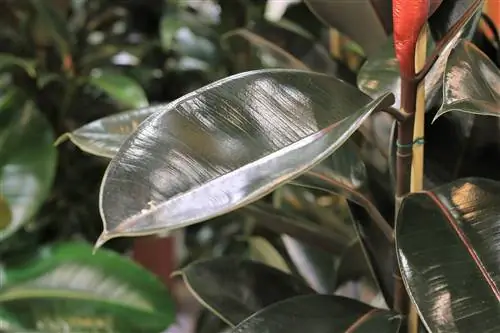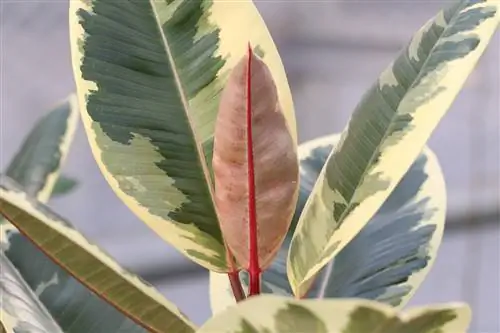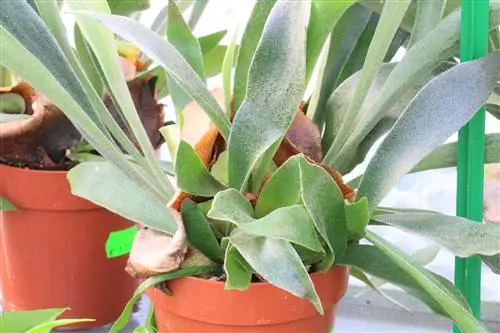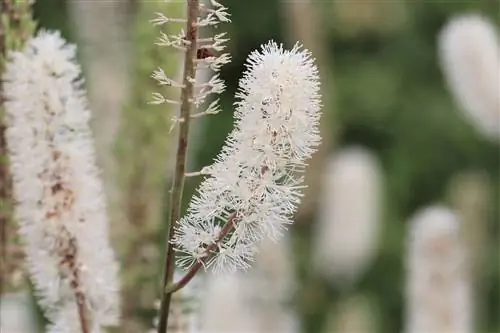- Author admin [email protected].
- Public 2023-12-17 03:39.
- Last modified 2025-01-24 12:45.
With a Ficus elastica, the opulence of the tropics moves into your living room at home. Where the rich green, shiny decorative leaves unfold, they create a feel-good ambience close to nature. Nobody will miss a flower here. The rubber tree harmonizes easily with every interior style from classic to modern, thanks to numerous imaginative varieties.
Explore the new creations that creative breeders have achieved here. The location in which the indestructible houseplant fully meets expectations will no longer be hidden from you. Practical care tips reveal useful details about successful cultivation.
Beautiful varieties
Ficus elastica ‘Robusta’
One of the most popular solitary plants for living spaces with large, oval-round leaves. The green plant owes its variety name to its remarkable resistance to both diseases and care errors. However, Robusta is very faithful to its location and does not like to be carried back and forth constantly.
Ficus elastica ‘Variegata’
This rubber tree impresses with beautifully variegated foliage in creamy white to light yellow. The brightly edged leaves create striking, decorative accents. This popular breed remains slightly smaller than its counterparts and looks excellent in offices and business premises.
Ficus elastica ‘Tineke’
The very dark foliage is variegated with white, which creates an eye-catching contrast. The leaf markings become more pronounced the brighter the location. Tineke is more sluggish than the plain green varieties and is recommended for small spaces.
Ficus elastica ‘Melany’
The variety impresses with its particularly dense habit and deep green to reddish leaves. These are a little smaller than usual, which impressively underlines the compact silhouette. Melany should not be exposed to bright sunlight because the rich colors could fade.
Ficus elastica ‘Belize’
One of the most colorful varieties within the plant genus with red-white-green variegated foliage. With a tight, upright growth, it serves as a distinctive eye-catcher on any windowsill. Since the height ranges between 60 and 180 cm, it can be adapted to any space thanks to its cutting compatibility.
Ficus elastica ‘Australis’
In contrast to the pure variety, the variety scores with its stocky growth. The shiny green leaves also shimmer when they are rubbed with algae juice from time to time.
Location
If you want to bring out all the beauty of your Ficus elastica, give it as bright a place as possible. Variegated varieties require even more light than the plain green ones. A rubber tree should be prepared for full sun gradually so that its leaves are not damaged.
- sunny to semi-shady location
- do not expose to cold drafts
- do not allow the temperature level to fall below 16 °C
- from May to September in the sheltered spot on the balcony
- shade behind glass in the blazing midday sun
- create an artificial light source in the twilight of room corners
So that the tropical green plant really feels at home, the humidity should reach a value of at least 50 percent. This is very easy to do by filling the coaster with pebbles and water. Without exposing the tree to the risk of waterlogging, the evaporating water rises and creates the desired tropical, humid environment.
Substrate
The substrate for a Ficus elastica should have a high degree of permeability in conjunction with a moderate nutrient content. This is achieved with high-quality potted plant soil that is enriched with perlite, sand, lava granules or a similar inorganic material.
Tip:
Always place a drainage system made of pebbles, grit or pottery shards over the bottom opening of the pot in order to specifically prevent harmful waterlogging. Only then is the substrate filled in.
Watering and fertilizing
The rubber tree is not a particularly thirsty roommate. The evergreen plant copes much better with short-term drought than with waterlogging. Ideally, the substrate should dry between waterings. A quick thumb test before each watering session will show whether there is any need at all. The nutrient supply, on the other hand, takes place according to a fixed schedule.
- Ficus elastica water moderately
- collected rainwater is preferable to calcareous tap water
- basically water directly to the roots
- Administer liquid fertilizer for green plants every 14 days from April to September
The rubber tree particularly likes watering using the immersion method. The bucket is immersed in low-lime water until no more air bubbles rise. After excess water has drained, place the tree back in its original location. By the next dive, the pot soil will almost dry out.
Wintering
A Ficus elastica does not take a break in the actual sense. Nevertheless, he slows down his biorhythm a little from October to February due to the darker lighting conditions. The need for irrigation water drops significantly. There is no need to add fertilizer at all. It is important to note that the temperature at the location does not fall below 16 °C.
Tip:
In order to compensate for the very dry heating air during the cold season, the rubber tree is occasionally sprayed with room temperature, lime-free water.
Cutting
A rubber tree in a living room will not come close to its natural growth height of 20 to 40 meters. If its size still exceeds the available space, it can easily be cut back. Here's how to do it:
- The months of January and February are recommended for the measure
- cut the top of the tree at the desired height
- shorten shoots that are too long until just above a sleeping eye
- Treat cuts with charcoal ash
Be sure to wear protective gloves while working, as the plant sap can cause serious allergies and skin irritations. With the start of the new growing season, the rubber tree increasingly sprouts from the sleeping eyes, resulting in a harmonious, compact habit.
Propagate
There are two options available for breeding, both of which require a heated indoor greenhouse. Both when propagating with cuttings and when sowing, temperatures of 28-30 °C are required.
Sowing
A seed tray or pot is filled with peat sand, seed soil or coconut fiber. Distribute the seeds on top and sift them thinly with sand. It is preferred to moisten with lime-free water from a spray bottle. Place the container in the mini greenhouse in the partially shaded window seat. The seeds are kept slightly moist at a constant temperature of around 30 °C. To prevent mold from forming, you should ventilate for a few minutes every day. After emergence, the seedlings can cope with slightly lower temperatures of around 25 °C. The young plants are transplanted into individual pots when they have 2-3 pairs of leaves.
Cuttings
Spring is the best time to vegetatively propagate a rubber tree. This is how the plan works:
- cut cuttings 10 cm long with a disinfected knife
- Treat the cuts immediately with charcoal ash
- the offshoots defoliate except for 1 leaf in the upper half
- Fill cultivation pots with lean substrate
- Insert one cutting deep enough that at least 1 eye is below the surface
- spray with lime-free water and place in the indoor greenhouse
At a temperature of around 30 °C, the cuttings will root within the next few weeks. The substrate must not dry out during this time.
Conclusion of the editors
With a Ficus elastica you are home to one of the most frugal green plants in the tropics. The lush green to brightly colored varieties transform every room into a small oasis of well-being with their lush habit. As long as there is no Egyptian darkness at the location and the temperatures do not fall below 16 degrees Celsius, a rubber tree thrives tirelessly and even filters the air we breathe. Proper care primarily revolves around moderate water supply and some fertilizer every 4 weeks.
What you should know about Ficus robusta
- The Ficus Robusta is known to most as the common rubber tree.
- It filters pollutants from the air and is therefore a popular office plant.
- Due to its leaf mass it is a good indoor climate improver.
- The rubber tree must be bright. If there is too little light, the leaves will fall off.
- Particularly the species with colored leaves need a lot of light.
- A few hours of sunlight is very beneficial for strong leaf color and he althy leaf formation.
- The ideal temperatures are between 20 and 25 ºC. It can also tolerate temperatures up to 10 ºC for short periods.
- In summer it can also be left outdoors, but should be protected from direct midday sun.
- A sheltered place is recommended, the Ficus Robusta doesn't like drafts at all.
- A good soil mix for rubber trees is compost based with a little peat.
- The pots for the Ficus Robusta should not be too large. If the roots are somewhat restricted, the plant develops best.
- Like all plants with large leaves, the rubber tree also needs a lot of water.
- In summer you water twice a week, in winter less.
- In summer, fertilization is carried out every 14 days with 0.2% fertilizer. In winter it is enough to fertilize every 4 weeks.
- The rubber tree can grow up to 5 meters high. However, it can be kept small by careful cutting.
- In addition, cutting the tip stimulates the side shoots to grow.
- The cuttings obtained can be used for propagation. However, they require temperatures of approx. 30 ºC to root.
- Head cuttings should be sprayed regularly with water.
- If you want to do something good for your rubber tree, you can wipe its leaves regularly with a cloth. The plant also likes to be showered.
- By the way: Ficus Robusta is also available as a hydro plant.
- When the leaves droop, the plant usually needs water. It's too dry.
- It's best to dip the pot once so that the soil can really soak up the water.
- If the leaves get brown spots and fall off, the plant is too cool.
- If the leaves turn yellow and fall off, the plant is too moist. The soil must be allowed to dry out between waterings.
- Do not keep the plant constantly wet. Spider mites and mealybugs can also occur.






